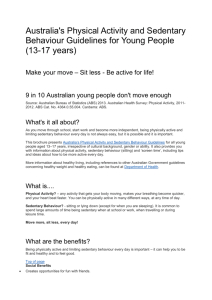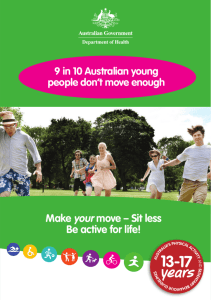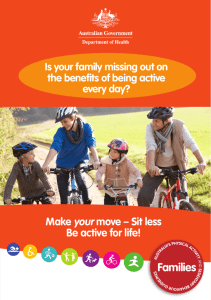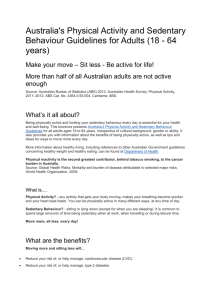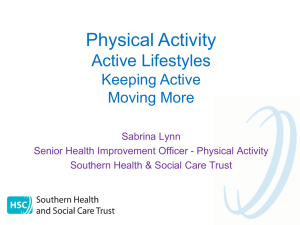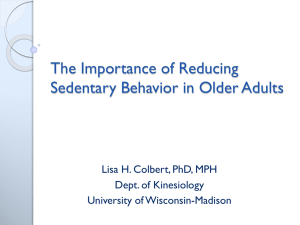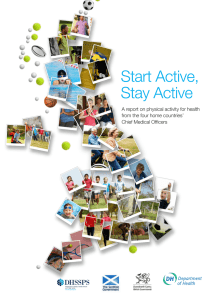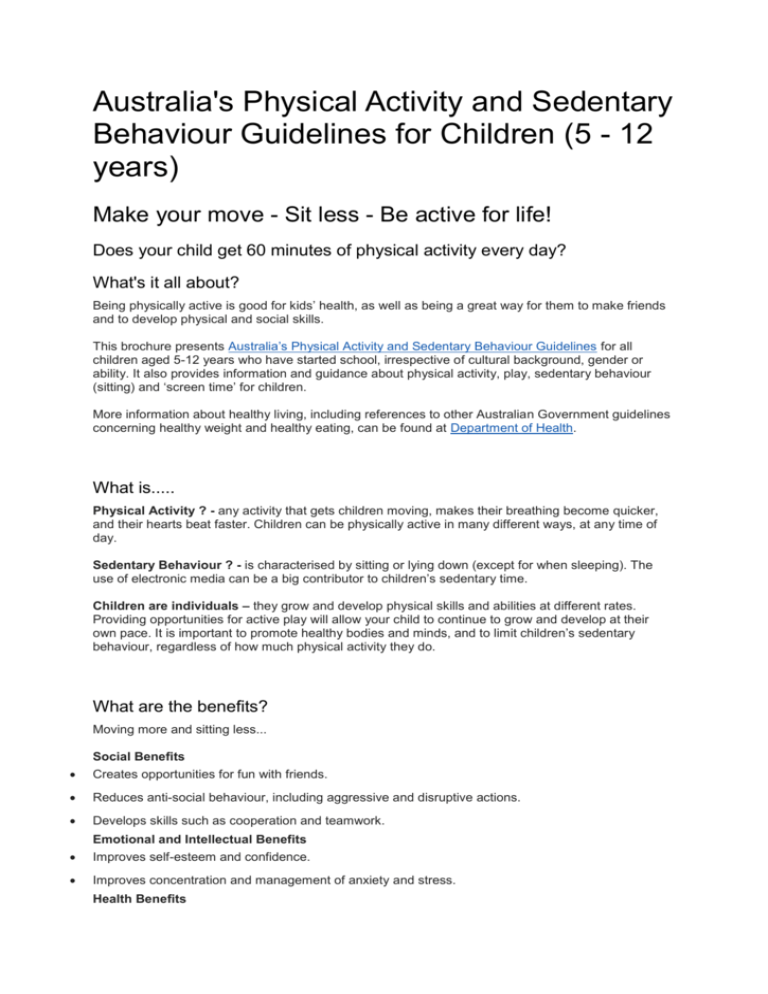
Australia's Physical Activity and Sedentary
Behaviour Guidelines for Children (5 - 12
years)
Make your move - Sit less - Be active for life!
Does your child get 60 minutes of physical activity every day?
What's it all about?
Being physically active is good for kids’ health, as well as being a great way for them to make friends
and to develop physical and social skills.
This brochure presents Australia’s Physical Activity and Sedentary Behaviour Guidelines for all
children aged 5-12 years who have started school, irrespective of cultural background, gender or
ability. It also provides information and guidance about physical activity, play, sedentary behaviour
(sitting) and ‘screen time’ for children.
More information about healthy living, including references to other Australian Government guidelines
concerning healthy weight and healthy eating, can be found at Department of Health.
What is.....
Physical Activity ? - any activity that gets children moving, makes their breathing become quicker,
and their hearts beat faster. Children can be physically active in many different ways, at any time of
day.
Sedentary Behaviour ? - is characterised by sitting or lying down (except for when sleeping). The
use of electronic media can be a big contributor to children’s sedentary time.
Children are individuals – they grow and develop physical skills and abilities at different rates.
Providing opportunities for active play will allow your child to continue to grow and develop at their
own pace. It is important to promote healthy bodies and minds, and to limit children’s sedentary
behaviour, regardless of how much physical activity they do.
What are the benefits?
Moving more and sitting less...
Social Benefits
Creates opportunities for fun with friends.
Reduces anti-social behaviour, including aggressive and disruptive actions.
Develops skills such as cooperation and teamwork.
Emotional and Intellectual Benefits
Improves self-esteem and confidence.
Improves concentration and management of anxiety and stress.
Health Benefits
Reduces the risk of developing type 2 diabetes and cardiovascular disease.
Improves physical fitness, including coordination and movement skills.
Reduces the risk of unhealthy weight gain.
Builds strong muscles and bones.
Promotes healthy growth and development.
Move more...
At least 60 minutes a day - in many different ways.
Children’s daily physical activity does not have to be done all in one go. The 60 minutes can be
accumulated throughout the day.
Remember, even if your child doesn’t play sport, there are lots of activities they can do. Being active
in a variety of ways will help children get all the benefits.
If your child is not doing 60 minutes of physical activity every day, they will benefit from gradually
increasing their activity to reach this amount.
So…10 minutes before school,20 minutes walking or riding to and from school and 30 minutes
of active play after school = 60 minutes.
How about walking, riding, skateboarding or scooting safely to school or other places…
...or washing the car, walking the dog,or helping to dig in the garden?
Intensity
While all physical activity is helpful, the Guidelines recommend moderate to vigorous intensity
physical activities.
Moderate Intensity Activities require some effort, but children can still speak easily while doing
them.
E.g. fast walking, riding a bike or scooter and active play.
Vigorous Intensity Activities require more effort and make children breathe harder and faster ('huff
and puff').
E.g. running, chasing and playing tag, and many organised sports like soccer or netball.
The more physical activity that children do - up to 3 hours per day - the more they will benefit.
...and sit less!
How much sitting is too much?
Even if children are very physically active, they will still benefit from limiting the amount of time that
they spend sitting or lying down (except when sleeping) in as many ways as possible.
Use of electronic media for entertainment should be limited to less than 2 hours per day.
You're right - there are some activities, like reading and doing school work, that may need to be done
while sitting. The key is to find a healthy balance and limit time spent in front of a screen for
entertainment.
Does 'free time' mean 'screen time' for your child?
Time spent using electronic media (such as television, seated electronic games, portable electronic
devices or computers) for entertainment, is referred to as 'screen time'.
While screen time activities may be popular, they usually involve sitting or lying down for long periods.
I could give gifts like skipping ropes, balls or kites to encourage active play.
I could set a 'no screen time' rule at dinner time and before school.
I could make my child's bedroom a TV and computer free zone.
I could reward the kids with a trip to the park, instead of TV or computer time.
There are many opportunities to sit in our daily lives. The key is to find opportunities to move.
What will you do?
Stronger bones, stronger muscles
As part of your child's daily 60 minutes of physical activity, it's important to include muscle and bone
strengthening activities on at least 3 days of the week.
Help children to grow strong bones and muscles by encouraging them to:
Skip, run, hop and jump.
Climb or swing on monkey bars and climbing frames.
Play games like tug-o-war and hopscotch.
Do structured activities like dance, gymnastics and martial arts.
Did you know that doing activities to strengthen bones and muscles is an important part of
healthy growth and development?
Why not try these ideas?
There are many ways for children to be physically active and to limit sedentary behaviour every day.
Active and Fun
Encourage children to play active games like obstacle courses, tag skipping or throwing a ball or
frisbee.
Visit playgrounds, parks, nature reserves, ovals or beaches.
Get children involved in a variety of different sports and activities.
Active Travel
For short trips, walk or ride safely.
For longer trips, park the car some distance away and walk with children for the rest of the trip.
Active at Home
Limit time for watching TV and using electronic games.
Store portable electronic devices out of sight.
Enjoy a walk with children around your local area.
Children can help with gardening activities like digging, sweeping or raking.
Active and Safe
Start slowly and build up the amount and intensity of physical activity
Protect children from the sun - ensure children wear sun-protective clothing, including a hat, and
apply sunscreen regularly.
Always supervise children appropriately when in and around water.
Speak with your doctor or other health professional if your child has a medical condition.
Be active every day in as many ways as you can!
Australia's Physical Activity and Sedentary Behaviour
Guidelines for Children (5-12 Years)
Physical Activity
For health benefits, children aged 5-12 years should accumulate at least 60 minutes of moderate to
vigorous intensity physical activity every day.
Children's physical activity should include a variety of aerobic activities, including some vigorous
intensity activity.
On at least three days per week children should engage in activities that strengthen muscle and bone.
To achieve additional health benefits, children should engage in more activity - up to several hours
per day.
Sedentary Behaviour
To reduce health risks, children aged 5 - 12 years should minimise the time they spend being
sedentary every day. To achieve this:
o
Limit use of electronic media for entertainment (e.g. television, seated electronic games and computer
use) to no more than two hours a day - lower levels are associated with reduced health risks.
o
Break up long periods of sitting as often as possible.
Australia' Physical Activity and Sedentary Behaviour
Guidelines
Move and Play Every Day - National Physical Activity Recommendations for Children 0-5 Years.
Make your move - Sit less - Be active for life!
o
Children (5-12 years)
o
Young People (13-17 years)
o
Adults (18-64 years)
o
Families
Choose Health: Be Active - A physical activity guide for older Australians.
To order these resources FREE OF CHARGE, phone 1800 020 103
Other Healthy Living Resources
Healthy Weight Guide
Eat for Health
Clinical Practice Guidelines for the Management of Overweight and Obesity in Adults, Adolescents
and Children in Australia
Get Up & Grow - Healthy Eating and Physical Activity for Early Childhood
To find out more please visit Department of Health.
© Commonwealth of Australia 2014, except for the images/photographs which are reproduced under
licence. All rights are reserved, unless permitted by the copyright Act 1968 (Cth). All information in
this publication is correct as at June 2014.

